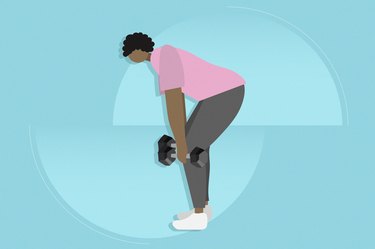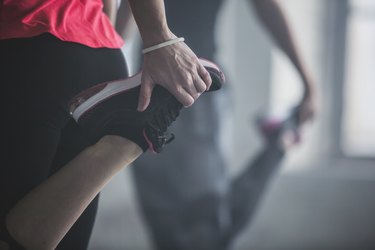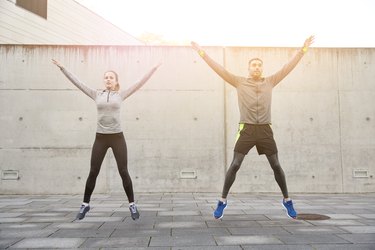
If you're not doing loaded carries — and more specifically, the farmer's walk — as part of your strength-training routine, you're missing out.
The farmer's walk targets muscles throughout your entire body, including your transverse abdominis, gluteals, quadriceps, hamstrings, calves, shoulders, latissimus dorsi (lats), traps, rear deltoids, biceps, triceps and forearms. And it strengthens all of those muscles while boosting your heart rate and cardio health, says Carolina Araujo, CPT, a California-based certified personal trainer.
Video of the Day
Read on to learn the benefits of this foundational exercise, and how to do the loaded carry for head-to-toe strength.
What Is the Farmer's Walk?
Also called a farmer's carry, it's a simple yet highly effective exercise that involves carrying heavy weights, usually kettlebells or dumbbells, in both hands while you walk forward. After you walk a given distance or run out of space, you set the weights down and repeat in the opposite direction.
You can program it into your workouts as a dynamic warm-up, main lift or exercise finisher.
How to Do Farmer’s Walk With Perfect Form
- Take a narrow stance with a set of dumbbells or kettlebells at your sides.
- Brace your core and push your hips back to grab the weights, then stand up.
- Stand with your feet hip-width apart and the weights hanging at your sides.
- Keeping your core tight, belly button in, squeeze your shoulder blades down and back to stabilize the weights.
- Walk forward, imagining there's a string pulling the top of your head toward the ceiling.
Farmer's Walk Muscles Worked
1. Core
This lift is, first and foremost, a compound ab exercise. Think of it like a moving plank: Your midsection is responsible for keeping your body upright and stable as you walk forward.
The bulk of the work goes to your transverse abdominis, the deep core muscles that support your spine and pelvis, and act like an internal weight belt.
2. Back, Shoulders and Arms
During the exercise, the muscles in your upper back and shoulders, including the trapezius, rotator cuff and deltoid muscles, work together to keep your shoulders strong and stable, Araujo says.
Meanwhile, your arms are equally active. As your biceps and triceps keep your arms rigid, your hands and forearms work hard to keep you holding on.
3. Hips and Legs
Loaded walk exercises target all of the muscles in your lower body. When performing the lift, your glutes, hamstrings, quadriceps and calves all work together to stabilize and propel you forward, Araujo says.
Related Reading
3 Benefits of the Farmer's Walk
1. Improved Posture
Strengthening your core, shoulders and back (all of which the farmer's walk targets) can drastically improve your spinal and pelvic alignment, according to the Mayo Clinic.
This reduces stress on both your upper and lower back. It also helps you do everyday tasks and in-the-gym exercises with better, safer form.
2. Burned Calories
That means they work several joints and major muscle groups all at once, according to the American Council on Exercise (ACE). Compound exercises require a lot of energy (aka calories) to do, meaning you can expect a big caloric burn from your walks.
3. Functional Strength
Alongside being a compound move, the farmer's walk is a functional exercise. In other words, the strength you build doing this exercise translates to a lot of your daily tasks out of the gym, according to Araujo.
Imagine carrying bags of groceries or a suitcase. These are real-life variations of the carry. And by training for them in the gym, you can move more confidently through every day.



